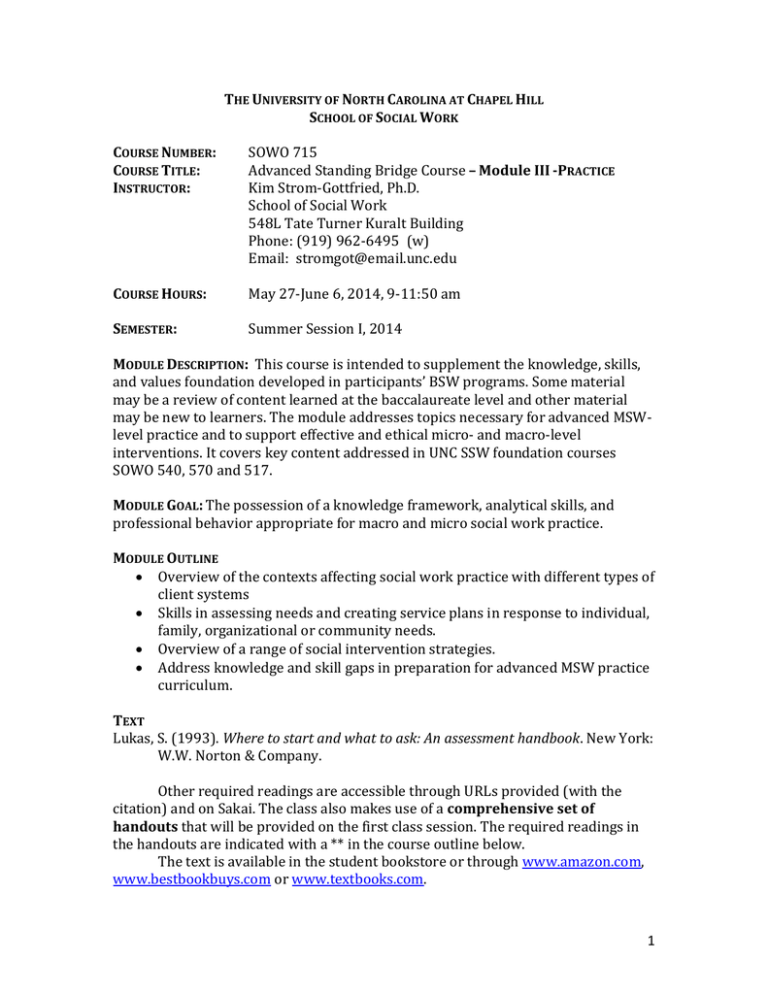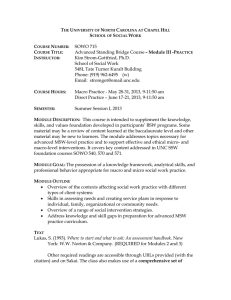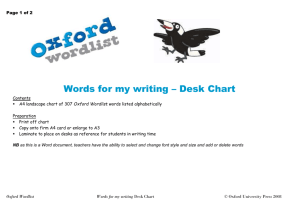SOWO 715 Advanced Standing Bridge Course Kim Strom-Gottfried, Ph.D.
advertisement

THE UNIVERSITY OF NORTH CAROLINA AT CHAPEL HILL SCHOOL OF SOCIAL WORK COURSE NUMBER: COURSE TITLE: INSTRUCTOR: SOWO 715 Advanced Standing Bridge Course – Module III -PRACTICE Kim Strom-Gottfried, Ph.D. School of Social Work 548L Tate Turner Kuralt Building Phone: (919) 962-6495 (w) Email: stromgot@email.unc.edu COURSE HOURS: May 27-June 6, 2014, 9-11:50 am SEMESTER: Summer Session I, 2014 MODULE DESCRIPTION: This course is intended to supplement the knowledge, skills, and values foundation developed in participants’ BSW programs. Some material may be a review of content learned at the baccalaureate level and other material may be new to learners. The module addresses topics necessary for advanced MSWlevel practice and to support effective and ethical micro- and macro-level interventions. It covers key content addressed in UNC SSW foundation courses SOWO 540, 570 and 517. MODULE GOAL: The possession of a knowledge framework, analytical skills, and professional behavior appropriate for macro and micro social work practice. MODULE OUTLINE Overview of the contexts affecting social work practice with different types of client systems Skills in assessing needs and creating service plans in response to individual, family, organizational or community needs. Overview of a range of social intervention strategies. Address knowledge and skill gaps in preparation for advanced MSW practice curriculum. TEXT Lukas, S. (1993). Where to start and what to ask: An assessment handbook. New York: W.W. Norton & Company. Other required readings are accessible through URLs provided (with the citation) and on Sakai. The class also makes use of a comprehensive set of handouts that will be provided on the first class session. The required readings in the handouts are indicated with a ** in the course outline below. The text is available in the student bookstore or through www.amazon.com, www.bestbookbuys.com or www.textbooks.com. 1 Other useful resources for you include: Mizrahi, T. & Davis, L., (Eds), (2008). Encyclopedia of Social Work, 20th edition. NY: Oxford University Press. Roberts, A.R. (Ed.) (2009) Social workers’ desk reference, 2nd ed. NY: Oxford University Press. TEACHING METHODS The success of this class depends on the development of a supportive learning environment, reflecting the values of the social work profession. This classroom culture is fostered by listening to the ideas and views of others, being able to understand and appreciate points of view which differ from your own, articulating clearly your point of view, and linking experience to readings and assignments. I appreciate your contributions to making this a respectful place for learning and growth. This course will use a variety of teaching and learning methods, including lectures, group discussion, role-plays, videos, cartoons and handouts. You are expected to actively participate, drawing from assignments, readings, other courses, and other experience. I will be available during the course by phone and email to address questions that may arise between class sessions. Please seek me out! CLASS ASSIGNMENTS Several methods will be used to determine your progress in the class and your achievement of the course objectives. The assignments are described below, and further information, including expectations, due dates, and grading criteria will be distributed during the first class session. All written assignments should use references following APA format and be typed or word processed using correct grammar, punctuation and spelling. Your score for this module will count toward one-third of your grade for the entire bridge course. Participation – is a vital part of your course performance. Credit for participation is earned by attending class, being on time and prepared, participating in exercises and role plays and contributing to class discussion based on your readings and experiences. Your participation grade will also be based on the evaluations of your classmates on your contributions in completing the group paper, below. It counts for 10% of your score on this module. Biopsychosociospiritual assessment and treatment plan- In this assignment, you will complete a comprehensive written assessment of a client, based on a videotaped interview, and present a preliminary goal and objectives, and a plan for intervention. The assignment and grading criteria are more fully described separately. It counts for 35% of your score on this module and is due by Monday morning 6/2. 2 Assessment and Systems Change Plan – You will be assigned a case, a large systems problem, and an organization. Your group will be asked to deliver a strategy for examining this problem, a preliminary assessment specific recommendations for large systems change. The assignment and grading criteria are more fully described later in the syllabus. It counts for 35% of your score on this module and is due by 5 pm 6/6. Quizzes – Quick quizzes (5 mostly multiple choice questions) will be given in each class session except for May 27 and 6/4). The quizzes will be used to assess your understanding of key terms and concepts from the readings and the day’s topics. Your cumulative score on the quizzes will be worth 20% of your grade for this module. WRITING ASSISTANCE The School of Social Work offers a variety of helpful writing resources on its website at http://ssw.unc.edu/students/writing. The School is also one of the few professional schools at UNC that provides writing support for its graduate students. Writing support is open to all students, but it’s a limited resource. You’re welcome to make an appointment to discuss specific writing issues and written assignments. Appointments are scheduled “first come, first served,” with priority given to those referred by faculty. Contact the Team at SOSWwritingsupport@gmail.com if you need assistance. POLICY ON ACADEMIC DISHONESTY In keeping with the UNC Honor Code, if reason exists to believe that academic dishonesty has occurred, a referral will be made to the Office of the Student Attorney General for investigation and further action as required. POLICY ON ELECTRONIC DEVICES IN THE CLASSROOM Please leave all electronic devices in your backpack or purse unless using them for taking notes or referring to readings. Please do not use them during discussions or for non-class purposes such as texting, checking mail, reading Facebook, etc. Checking devices, even briefly, during class is disruptive to discussions and distracting to others. 3 READINGS AND COURSE OUTLINE The class format is based on the understanding that you are prepared and active learners. Reading the assigned materials prior to the date they are due is a prerequisite to getting the most out of class sessions and successfully meeting the course objectives. Because this summer session is intended to supplement your BSW learning, some readings will be repetitive of your past class work and you may skim them. Focus on the readings that cover topics that are less familiar to you. The handouts marked** are also required readings. 1. TUESDAY, MAY 27 Introductions Written introductions Overview of module, assignments and mutual expectations The context of practice The links between micro and macro practice Case exercise The links to other modules (evidence-based practice, theory, systems, life cycle, policies, cross-cultural practice, etc.) Needs assessments Purposeful use of self Share FYI book Handouts: Context PowerPoint Self-understanding and Self-discipline Terms & Concepts Readings: None 2. WEDNESDAY, MAY 28 Submit self-assessment Interviewing Identify and critique interviewing skills: Reynolds Video Motivational interviewing Introduction to multidimensional assessment and mental status exams Handouts: Multidimensional assessment powerpoint slides Interview skills checklist Interview exercise colored squares Readings: Lukas: Chapter 1: How to Conduct a First Interview with an Adult Chapter 2: Looking, Listening, and Feeling: The Mental Status exam 4 Chapter 4: How to Conduct a First Interview with a Family Chapter 5: How to Conduct a First Interview with a Child Mizrahi, T., & Davis, E. (2008). Motivational interviewing. In Encyclopedia of Social Work. Retrieved May 7, 2013, from http://www.oxfordreference.com/view/10.1093/acref/97801953066 13.001.0001/acref-9780195306613-e-252?rskey=eVOuNd&result=182&q= 3. THURSDAY, MAY 29 Assessment concepts and skills – individuals, families, children Biopsychosociospiritual Assessment Link to HBSE/theory/DSM/spirituality/culture and other concepts already covered Video for BPSS paper Handouts/Resources: **Suggested questions to address spirituality One suggested psychosocial outline Family and Couples ppt ** Crisis and suicide handouts ** Writing assessments **Cournoyer on Eclectic Practice **Cournoyer on Interventive Techniques Cournoyer on Brief Treatment Readings: Lukas: Chapter 3: How to Think About Your Client’s Health Chapter 6: How to Take a Developmental History Chapter 10: How to Determine whether a Client is a Substance Abuser Chapter 8: How to Determine whether a Client Might Hurt Somebody- Including You Chapter 9: How to Determine Whether a Client Might Hurt Herself Chapter 11: How to Assess Children for Neglect, Abuse, and Sexual Abuse Boyd-Webb, N. (2009). Play therapy with children in crisis. In Albert R. Roberts (Ed.), Social Workers’ Desk Reference (2nd ed.) (pp. 647-652). New York: Oxford University Press. Austrian, S. G. (2009). Guidelines for conducting a biopsychosocial assessment. In Albert R. Roberts (Ed.), Social Workers’ Desk Reference (2nd ed.) (pp. 376380). New York: Oxford University Press. 5 Hopson, L.M. & Wordarski, J.S. (2009). Guidelines and uses of rapid assessment instruments in managed care settings. In Albert R. Roberts (Ed.), Social Workers’ Desk Reference (2nd ed.) (pp. 400-405). New York: Oxford University Press. 4. FRIDAY, MAY 30 Contracting and treatment planning Interventions for change – direct practice Build on theories introduced in HBSE CBT Task centered Crisis Psychotropic medications Case and group assignments for large systems change paper Handouts: ** Psychotropic Medications ** Goal Setting and Treatment Planning ** Writing assessments ** Cournoyer on Eclectic Practice ** Cournoyer on Selecting Interventions Cournoyer on Brief Treatment Reading: Vonk, M.E. & Early, T.J. (2009). Cognitive-behavioral therapy. In A.R. Roberts (Ed.) Social workers’ desk reference (2nd ed.), (pp. 242-247). New York: Oxford University Press. Garvin, C. (2009). Developing goals. In A.R. Roberts (Ed.) Social workers’ desk reference (2nd ed.) (pp. 521-526). New York: Oxford University Press. Dejong, P. (2009). Solution-focused therapy. In Albert R. Roberts (Ed.), Social Workers’ Desk Reference (2nd ed.) (pp. 253-258). New York: Oxford University Press. Fortune, A. E., Reid, W. J., & Reyome, D. P. (2009). Task-centered practice. In Albert R. Roberts (Ed.), Social Workers’ Desk Reference (2nd ed.) (pp. 226-230). New York: Oxford University Press. Franklin, C., Jordan, C., & Hopson, L.M. (2009) Effective couple and family treatment. In Albert R. Roberts (Ed.), Social Workers’ Desk Reference (2nd ed.) (pp. 433442). New York: Oxford University Press. 6 Howard, M. O., Perron, B. E., & Vaughn, M.G. (2009). Practice guidelines and evidence-based practice. In Albert R. Roberts (Ed.), Social Workers’ Desk Reference (2nd ed.) (pp. 1157-1162). New York: Oxford University Press. 5. MONDAY, JUNE 2 Understanding Communities Personal experiences and community competence Asset-based community assessment Reading: Sharpe, P. A., Greaney, M. L., Lee, P. R., & Royce, S. W. (2000). Assets-oriented community assessment. Public Health Reports, 205-211. Retrieved from http://www.ncbi.nlm.nih.gov/pmc/articles/PMC1308712/pdf/pubhealthre p00022-0103.pdf The Community Tool Box. (2012). Chapter 3: Assessing community needs and resources. Read the following sections: Section 2: Understanding and describing the community. Section 5: Analyzing community problems. Craig, S. L. (2011). Precarious partnerships: Designing a community needs assessment to develop a system of care for gay, lesbian, bisexual, transgender, and questioning (GLBTQ) youths. Journal of Community Practice, 19(3), 274-291. OPTIONAL Kretzmann, J. & McKnight, J. (2005). Discovering community power: A guide to mobilizing local assets and your organization’s capacity. W.K. Kellogg Foundation. http://www.sesp.northwestern.edu/images/kelloggabcd.pdf 6. TUESDAY, JUNE 3 Understanding Organizations Culture and climate Power Life-cycle Fiscal functioning Reading: Hemmelgarn, A. L., Glisson, C. & James, L. R. (2010). Organizational culture and climate: Implications for services and intervention research. In Y. Hasenfeld (Ed.), Human services as complex organizations (2nd ed.). Thousand Oaks, CA: Sage. W.K. Kellogg Foundation. (2006). Budget development and financial guidelines. Retrieved April 24, 2010 from http://www.wkkf.org/knowledge- 7 center/resources/2009/09/Budget-Development-And-FinancialGuidelines.aspx Gibelman, M., & Furman, R. (2007). How organizations are financed. Navigating human service organizations: Essential information for thriving and surviving in agencies (2nd ed.) (pp. 48-73). Chicago: Lyceum. North Carolina Coalition Against Domestic Violence. (n.d.). Wise women’s favorite fundraising strategies. Retrieved May 22, 2012 from http://www.vawnet.org/Assoc_Files_VAWnet/WiseWomenFundraising09.p df Hardcastle, D. A. & Powers, P. R. (2004). Using your agency. (pp. In Community practice: Theories and skills for social workers (2nd ed.). New York: Oxford University Press. National CASA Association. (2000). Sample operating budget. Retrieved April 24, 2010 from http://nc.casaforchildren.org/files/public/community/programs/Indicators Compliance/0803_operating_budget2_0053.pdf FYI: Review the following North Carolina foundation websites to identify a) funding areas/priorities; b) application procedures and guidelines; and c) the type of organizations and programs that are getting funded: http://www.mrbf.org/ http://www.zsr.org/ http://www.kbr.org/ http://www.fundforsouth.org/ 7. WEDNESDAY, JUNE 4 Tools for change in organizations and communities Groups Human resources Strategic planning, SWOT analysis Force-field analysis Logic models The 5 Ps Social Action Social Planning Locality development Legislative advocacy Handouts: **Three Models of Community Organization **1987 NCPCA outline for large systems change 8 **Organizational Change Force Field Form (blank and example) **Problem Analysis and Strategy Selection Groups in Social Work Practice Group Process Techniques **Understanding Task Groups **Tropman & Morningstar outline Readings: ***W.K. Kellogg Foundation. (2010). Logic Model Development Guide. Retrieved April 24, 2010 from W.K. Kellogg Foundation. (2006). Budget development and financial guidelines. Retrieved April 24, 2010 from http://www.wkkf.org/knowledge-center/resources/2006/02/WK-KelloggFoundation-Logic-Model-Development-Guide.aspx *** Read Chapter 1, though you may want to use the others and the following site for additional understanding: University of Wisconsin-Extension (n.d.). Logic models to enhance program performance. Retrieved August 7, 2007, at http://www.uwex.edu/ces/pdande/evaluation/pdf/LMpresentation.pdf Hardcastle, D. A. & Powers, P. R. (2004). Using work groups: committees, teams, and boards (Chapter 10). In Community practice: Theories and skills for social workers (2nd ed.). New York: Oxford University Press. Community Toolbox. Chapter 19 Choosing and Adapting Community Interventions (read the “Main Section” of Sections 1-5). Found at: http://ctb.ku.edu/en/table-of-contents/analyze/choose-and-adaptcommunity-interventions 8. THURSDAY, JUNE 5 Gaps, leftovers and Q & A Catch up time for delayed content Consultation group meetings 9. FRIDAY, JUNE 6 Working across difference in micro and macro practice “An Unlikely Friendship” Termination with systems of all sizes Class terminations and evaluation Handouts: **Rules for Dominant Culture Organizers (p. 147) **Termination powerpoint (p. 148) 9 Readings: Hardy, K. (1993). War of the worlds The Family Therapy Networker, 51-57 Al-Krenawi, A. (1998). Reconciling western treatment and traditional healing: A social worker walks with the wind. Reflections,4(3), 6-21. Community Toolbox. Chapter 27 Cultural Competence in a Multicultural World, Sections 1, 2, and 5. Found at http://ctb.ku.edu/en/tablecontents/chapter_1027.aspx 10 Biopsychosociospiritual Assessment For this assignment, you will review a video depicting an interview with a client and use it to create a biopsychosociospiritual assessment, including preliminary treatment goals, objectives, and intervention plan. The intent of this assignment is to mirror as closely as possible what might be expected of you in writing an assessment following a session with a client. You may take hand-written notes during the video; however, you may not record the video in any way, and you may not use your computer during the viewing. You may not consult with fellow students in the preparation of this assignment. You will be graded on the accuracy and clarity of your assessment, but you may choose from a number of relevant goals for work, as long as they are consistent with the assessment findings and are supported by material from the course and the practice literature. Your paper should be approximately six pages in length, exclusive of cover page and bibliography. Use 1” margins and 12-point Times New Roman type. Do not double double space between sections. Since these papers will be graded anonymously, put your name, signed honor code, and unique identifier (number, name, or letters) on the cover page. Submit this separately from the body of the paper. Only your unique identifier should appear on the body of the paper. Course readings and handouts provide guidance for preparing a biopsychosociospiritual assessment, but your assessment should follow the format below: 1. Demographic information, presenting problem, and mental status 2. Current and previous agency contacts 3. Medical, psychiatric, and substance abuse history and data 4. Brief history of the client, including salient relationships with significant others 5. Your (clinician’s) problem formulation, including mitigating interpersonal, and environmental factors and client strengths 6. Preliminary treatment plan: (one goal, related objectives, and suggested interventions). 11 Assignment 3: Biopsychosociospiritual Assessment Grading Standards Unique Student Identifier: ___________________________ Evaluation Elements: The introductory section, demographic information, and mental status exam are clearly written, conveying an accurate impression of the client and the presenting problem. The assessment clearly and accurately describes the problems and includes impressions of biopsychosocial factors, relevant historical and developmental information, and client strengths and resources. Initial goals are properly written and linked to assessment findings. Objectives are observable, feasible, and measurable. Interventions are thoughtfully chosen, linked to assessment and goals, and supported by the literature. The document reflects an understanding of various dimensions of diversity as they may apply to the assessment, goals, intervention, and evaluation. The document is well-written, uses nonjudgmental language, and demonstrates basic mastery of sentence structure, with no errors in spelling, punctuation, grammar, or typing. Total Points Score 20 25 20 20 5 10 100 Comments: 12 LARGE SYSTEMS PROBLEM ASSESSMENT AND CHANGE PLAN DUE DATE: FRIDAY JUNE 22 (OR BEFORE) For this paper, you and a group of 3-4 other students will be assigned a large systems problem and will be expected to offer a coherent strategy for assessing and addressing the problem. Although the case is real, your assessment and interventions will be hypothetical. You are free to state any premises on which your group based its decisions, but is still important that your analysis and recommendations be based on realistic policy, practice and resource considerations. Your paper should be approximately 10 pages in length, exclusive of cover page, bibliography and appendices. Use 1” margins and 12-point Times New Roman type. Do not double double space between sections. Since these papers will be graded anonymously, put all group members’ names, signed honor code, and a unique identifier (number, word, or letters) on the cover page. Indicate which group member should receive the graded paper when it is returned. Submit the cover page separately from the body of the paper. Only your unique identifier should appear on the body of the paper. Your paper should be organized in the following manner: Executive Summary Provide a succinct summary of the issue, importance, and the intervention recommended. Issue Overview Describe the issue, related elements, and why it is important that it be addressed now. Present findings from academic research that demonstrate the scope and impact of the issue. Data Collection Present a plan with your recommended steps for a) further exploring the problem and interrelated factors, and b) identifying best practices to address the problem. Describe the role that consumers and stakeholders will play in needs assessment and development of change strategies. Assessment Based on the research you have conducted to this point, present a theory of change and logic model for the initiative, explaining WHY you are doing what you are doing, WHAT you are doing (the expected results, short, intermediate, and long-term outcomes) and identify how the initiative’s activities will contribute to achieving those outcomes. This will involve clearly linking the elements that you believe create and sustain the problem and require you to specify which change approach (of the five Ps: Policy, Program, Project, Personnel, Practices) you have decided to pursue. Change plan Conduct a force field analysis of the factors that you envision advancing your plan and restraining it (append the analysis to your paper). In a narrative, describe the 13 key points of intervention and the tactics and strategies you will use to create change. Financial Management Identify the full, expected and reasonable costs of the initiative, explaining and justifying major costs. Create a budget that is well formatted and easy to read and understand. Identify strategies to finance the program and provide specific and well reasoned ideas for diversified funding sources and types. Strengths and Limitations What were the particular strengths and limitations of your plan? What did you learn about the availability of models to use in this process? What did you learn about your own biases? What are some challenges to dialogue and action? What does this experience suggest that you need to do to prepare yourself as social workers in macro practice? Appendix This should contain clean, edited copies of your budget, logic plan, and force field analysis. References Course materials and outside resources to support your assessment and strategy for large systems change. Self-/Team-assessment (Each student completes this separately using a form to be provided.) Each team member will evaluate his/her own personal contributions and those of other team members. This will be used by students for self-evaluation and examination of the task group process, and as an instrument to assure responsible and effective individual contributions to the task group product. 14 LARGE SYSTEMS ASSESSMENT AND CHANGE PLAN Grading Standards Unique Identifier for Group: ___________________________ Evaluation Elements: Executive summary clearly and succinctly summarizes the paper’s contents The issue overview conveys and substantiates with research the import of the issue and why it is important that it be addressed. Clearly describes a plan for exploring the problem and identifying best practices to address it. Accurately and thoroughly identifies factors that create or sustain the problem. The problem assessment and change approach are thoughtfully constructed and clearly articulated in narrative and in the logic model. The logic model is appended. A force field analysis thoroughly depicts forces sustaining the status quo and is appended to the document. The intervention reflects findings in the assessment and the application of course materials on strategies for systems change. Full, expected and reasonable costs of the program are clearly identified in the budget. The budget is well formatted and easy to read and understand. Major costs are well explained and justified. The resource development plan contains reasonable assumptions about how the organization can finance the program and specific and well reasoned ideas for funding sources. The resource development plan also reflects an understanding of revenue diversification and restricted/unrestricted funding concepts. The document reflects an understanding of various dimensions of diversity as they may apply to the assessment, goals, and intervention. The document reflects self-awareness on the part of group members and comprehensively captures strengths and weaknesses in the plan and in task group processes. The document is properly formatted, well-written, uses nonjudgmental language, and demonstrates basic mastery of sentence structure, with no errors in spelling, punctuation, grammar, or typing. Total Points Score 5 15 10 15 15 15 5 10 10 100** ** Individual adjustments in group score are made in response to members’ individual peer evaluations. Comments: 15







